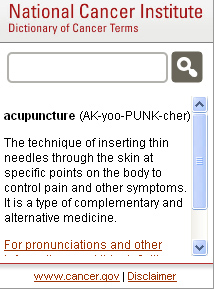Meetings and Events
Spring 2013
Vol. 8, Issue 1
Winter 2013
Vol. 7, Issue 2
Spring 2012
Vol. 7, Issue 1
Spring 2011
Vol. 6, Issue 1
Fall 2011
Vol. 6, Issue 2
Spring 2010
Vol. 5, Issue 1
Fall 2010
Vol. 5, Issue 2
Spring 2009
Vol. 4, Issue 1
Fall 2009
Vol. 4, Issue 2
Spring 2008
Vol. 3, Issue 1
Fall 2008
Vol. 3, Issue 2
Fall 2007
Vol. 2, Issue 2
Winter 2007
Vol. 2, Issue 1
Summer 2006
Vol. 1, Issue 2
Research Resources
NIH opens pathways for collaborations between intramural and extramural investigators
In the world of NIH research, one is either an extramural (works in a lab outside of NIH) or intramural (works at the NIH) researcher, a distinction that provides different access to research resources. As intramural researchers, NIH scientists have access to numerous resources including equipment, technology, patient cohorts, and specimens. Most of these resources are normally off-limits to extramural researchers; however, a new grant program, “Opportunities for Collaborative Research at the NIH Clinical Center (U01),” has been established to encourage collaboration between extramural investigators and intramural NIH researchers and provide extramural researchers with an opportunity to utilize the vast research resources at the NIH Clinical Center.
Interested extramural researchers are encouraged to determine the NIH investigators they’d like to work with, by searching the National Intramural Database (NIDB) for a specific investigator (http://intramural.nih.gov/search/index.taf?_UserReference=AD7D6C5DCD73B18F4F68A767). Researchers can also conduct searches, using specific key words or phrases to identify intramural research protocols aligned with their research area using the Search the Studies-NIH Clinical Research Studies website (http://clinicalstudies.info.nih.gov/index.html). Interested researchers can also search for a specific research resource by browsing the Resources page on the “Collaborating with NIH Intramural Investigators” website (http://clinicalcenter.nih.gov/translational-research-resources/resources.html). Examples of resources available to extramural researchers include equipment, technology and tools, such as radiology and imaging; biomedical specimens; protocol support and unique data sets; and databases of healthy volunteers.
Once an intramural researcher or a research resource is identified, extramural researchers are encouraged to contact the NIH investigator who oversees the specific resource. Before any collaborative scientific research may occur both the intramural and extramural investigators must sign the appropriate written agreements.
The collaborative science efforts and use of the Clinical Center resources are supported via two funding opportunity mechanisms:
- The "Opportunities for Collaborative Research at the NIH Clinical Center (U01),” which requires extramural investigators to collaborate with a Principal Investigator/Co-Investigator in the NIH Intramural Program and allocates $500,000 per year in direct costs for a period of three years. http://grants.nih.gov/grants/guide/pa-files/PAR-13-029.html
- Administrative supplements for Bedside-to-Bench projects, which involve intramural and extramural collaboration for translational research projects and award $135,000 per year in direct costs for up to two years.
http://clinicalcenter.nih.gov/ccc/btb/index.html
The location of each collaboration is variable and may include, but is not limited to, the extramural investigator working at his/her home institution and the intramural researcher at the Clinical Center, the extramural researcher taking a sabbatical to conduct research at the Clinical Center, or a trainee/junior faculty member relocating to the NIH to manage or conduct a project. Extramural investigators who want to conduct research at NIH must apply for an NIH appointment.
Ultimately, this program provides investigators with an opportunity to work together, fostering new ideas and potentially new scientific discoveries as a result of collaborative efforts. To learn more about collaborating with NIH intramural investigators, visit http://clinicalcenter.nih.gov/translational-research-resources/index.html.
NCI launches Dictionary of Cancer Terms Widget

Trying to find credible and reliable medical information on the Internet can sometimes be a frustrating endeavor, but trying to decipher this information shouldn’t be. Many of the words and phrases weaved throughout medical literature, like thrombocytopenia and cachexia, form their own language leaving the reader to guess the meaning of the word or phrase.
To increase cancer health literacy and user comprehension of unfamiliar terms, the National Cancer Institute (NCI) has recently developed a widget of one of its most popular resources, the Dictionary of Cancer Terms. Widgets are small applications which can be installed on any existing website. Adding NCI’s widget to your website provides visitors with access to over 7,200 cancer definitions in easy-to-understand language without ever having to leave your site. Cancer terms are available in both English and Spanish.
“If you are looking for a definition of a cancer-related medical term on Google, chances are the definition comes from NCI’s Dictionary of Cancer Terms. It is one of NCI’s most used information resources. We wanted to make this resource even more easily accessible to people who visit other websites such as NCI-designated Cancer Centers, cancer advocacy groups, and blogs” – Lakshmi Grama, Senior Digital Content Strategist, NCI.
In addition, this free web application does not require any technical maintenance once it is installed on your site. As NCI changes or adds content, these changes will be reflected in the searches on your site. To add this widget to a website or blog, visit http://www.cancer.gov/global/widgets/dictionary and follow the instructions provided.





